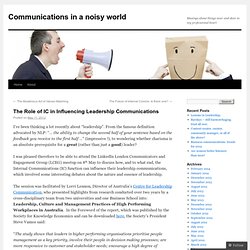

The message you didn’t know you sent « Spread the Word. Closed-door meetings.

Extra “suits” wandering around. A sudden flurry of communications. As we help organizations communicate with employees, one issue that regularly rises to the top is the unintended communication that results from little changes in office routine. Think about it: Nothing sends a wave through an organization faster than a bunch of C-level leaders and VPs scurrying from office to office for closed-doors huddles.
When they emerge with eyes down and manila folders in hand, they can cause more panic than any shout of “Fire!” "Chief Engagement Officer:” The Role of CEOs in Internal Communication - Institute for Public Relations. In a recent interview with McKinsey & Company in April 2014, Richard Edelman used the term “chief engagement officer” to describe a Chief Executive Officer’s (CEO) new role, when discussing how today’s leaders can regain public trust. Rather than merely formulate policies, CEOs must step forward, meet communities both internally and externally, establish personal relationships, and genuinely listen to people’s concerns.
I cannot agree more! CEOs and their organizations are naturally linked together. Canadian HR Reporter - Article - 6 in 10 employees don’t trust their senior leaders: Survey. Six in 10 (61 per cent) of Canadian employees don't trust their senior leaders, according to a survey by the Canadian Management Centre and Ipsos Reid.

Only 39 per cent of Canadians trust what their senior leaders say and less than four in 10 feel that senior leadership is doing a good job of communicating what is happening in their workplace, found Build a Better Workplace: Employee Engagement Edition, which surveyed 1,200 Canadian workers. Less than one-half (44 per cent) of Canadian employees have confidence in the senior leadership of their organization.
The confidence that employees have with senior leadership varies considerably by industry. Those in transportation (32 per cent), government (35 per cent) and retail industries (39 per cent) exhibit the lowest levels of confidence in their senior leadership. The highest levels of confidence were reported by employees in high tech/IT (55 per cent), found the survey. The Role of IC in Influencing Leadership Communications. I’ve been thinking a lot recently about “leadership”.

From the famous definition advocated by NLP: “… the ability to change the second half of your sentence based on the feedback you receive to the first half …” (impressive !) , to wondering whether charisma is an absolute prerequisite for a great (rather than just a good) leader? I was pleased therefore to be able to attend the LinkedIn London Communicators and Engagement Group (LCEG) meetup on 8th May to discuss how, and to what end, the Internal Communications (IC) function can influence their leadership communications, which involved some interesting debates about the nature and essence of leadership. The organisational performance of the 78 participating services-based organisations (e.g. law firms, advertising companies, accounting firms, consulting firms, employment agencies etc.) was assessed using 18 performance measures in six categories.
What are the top three qualities that you look for in a good leader? Attention Leaders: We Need to talk by Frank Sonnenberg. To succeed in today’s competitive marketplace, organizations must give internal communication the priority that it deserves.

They must view it as an avenue to release the creative genius of an organization, not as a bothersome chore. After all, communication acts as a powerful agent of change, a source of continuous improvement, and a catalyst for moving the organization forward. According to 2010 Towers Watson Communication ROI Study Report, “Companies with highly effective communication had 47 percent higher total returns to shareholders over the five-year period (mid-2004 to mid-2009) compared with companies with less effective communication practices.”
Lonely at the top: how a CEO drives employee engagement. Throughout the 1980s and early 1990s Continental Airlines was ranked bottom of nearly every category used to measure airline performance.

The company went through 10 CEOs in a decade, had to ask for bankruptcy protection twice and, at it’s lowest point, made losses of over $600m per year. CEC Insider » The Overlooked Communications Ingredient. CEC members ask us questions about improving internal communications on a daily basis.

They want to know about communicating new strategy, cascading new company values, reducing e-mail volume, improving employee engagement, implementing a culture shift, etc. etc. etc. What’s interesting is that we don’t hear the question that is perhaps one of the most important of all – “How do we enhance our line manager dialogue?” Employees need to talkwith someone who grasps both their world and the bigger picture. Senior leaders, communications, or anyone at the corporate center can never have the proximity, credibility, or understanding of employees that managers have. Social Network With Your Staff - HAPPI. April 7, 2014 Singe day education event hosted by supplier.

Read More » Cross-Cultural Leadership: How to Create People Alignment (Part 3) Photo: Tuppys/Flickr (Creative Commons) This series is about people alignment as a crucial competence for today’s leaders.

Overcoming the perennial block on effective message cascade. I’m talking about that mid management level in the organisation where, habitually, the cascade process breaks down as evidenced by employee surveys and the like.

C-Level Exec, Improve Your Brand Image by Using Social Media. I immediately thought of singer Billy Joel's classic song, "A Matter of Trust," when I read the findings of a study that revealed the ever-growing importance and need for C-level suite folks to use social media to engage its customers and prospects, and to earn their trust in the process.

In the song, the piano man sings of the “constant battle for the ultimate state of control.” We all know that battle has been won; the consumer is in complete control. And any smart and wise C-level suite exec also realizes that, again to paraphrase Joel, the consumer “can take it or leave it, whatever they choose.” The “it” is your brand, your company, etc. Nonverbal Communication and Employee Engagement. Nonverbal Communication and Employee Engagement Posted on Fri, Jun 15, 2012 I recently had the opportunity to hear a fascinating discussion on “Deaf Culture in America.” The speaker shared a from-the-heart story about growing up as the talking, hearing child of two deaf parents (also known as a CODA – child of a deaf adult, apparently). Conversation Starter: How Intimate Are You? - Boris Groysberg and Michael Slind.
By Boris Groysberg and Michael Slind | 8:00 AM June 11, 2012 The root cause of organizational dysfunction is often distance — the distance between leaders who communicate in a top-down fashion and employees who develop a sense of estrangement from those leaders. When that distance remains wide, the work of moving crucial information and key ideas across an organization becomes harder and harder.
This gap can grow until it becomes a chasm: As leaders lose touch with their people, they lose the ability to maintain the sort of feedback process that enables organizational effectiveness. They neither truly speak to employees nor hear what employees have to say. This leadership gap is evident at all manner of organizations. The Four I's of Leadership Communication by @ginidietrich.
I’ll admit it. I read the Fifty Shades of Grey trilogy. I had to see what all the fuss was about. When I finished, I bought myself a copy of the June issue of Harvard Business Review, just so I could read something smart and well written. And, boy, am I glad I did! Internal Communications Excellence: Engaging Middle Management. Why blog or tweet? An NHS leader shares his view.
Why blog or tweet? An NHS leader shares his view Professional communicators spend hours influencing and persuading their stakeholders and business partners. One conversation which has become increasingly popular is the importance of senior management regularly communicating with employees, particularly through social media. Daniel Munslow - The role of leadership in the communication cycle. Strata Communications - Five tips for effective internal communication. Center for Values-Driven Leadership: Hey Leaders! Are You Listening MORE Than You are Talking? Employee-Executive Lunches - Case Study: GE Healthcare. The Leadership Team Needs to Be “Branded”. How about a Logo? « INTRASKOPE – INTERNAL COMMUNICATION VIEWPOINT FROM INDIA. Communication Best Practices for Leaders: Increasing Employee Engagement.